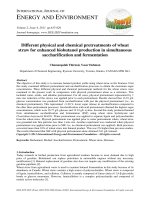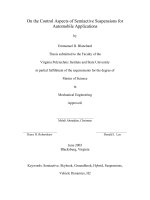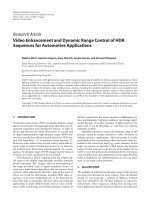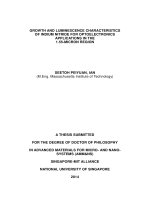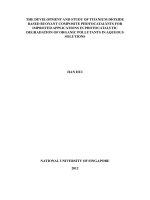Chemical modifications of natural fibres for composite applications
Bạn đang xem bản rút gọn của tài liệu. Xem và tải ngay bản đầy đủ của tài liệu tại đây (3.94 MB, 53 trang )
Chemical Modifications of Natural Fibres for Composite
Applications
KETKI SURESH CHAVAN
Final Year B.Tech F.T.P.T.
201003021052
Seminar Report Presentation on:
Introduction to Composites…
Heterogeneous nature
created by the assembly of two or more components with fillers or reinforcing fibres and a compactable matrix
Constituents of a Composite material are:
Reinforcement: Discontinuous, Stiffer, Stronger.
Matrix: Continuous, Less Stiff, Weaker
Interface: A third phase exists between reinforcement and the matrix because of chemical interactions or other
processing effects
plays an important role in controlling failure mechanisms, fracture toughness
2
Fibre Reinforced
Composites
Single Layer
(same orientation & properties
in each layer)
Continuous fibre
Reinforcement
Unidirection Reinforcement
Bi directional
Reinforcement
(woven fabric)
Discontinuous fibre
Reinforcement
Random Orientation Preferred orientation
Multi layer
(angle ply)
Laminates Hybrids
Classification of FRCs.
3
Ref.:Agrawal B D & Broutman L J, 1980
Market Trends for NFRCs
Automotive & Construction were largest segment among all natural
composite applications.
Several automobile models, first in Europe and then in North America,
featured natural reinforced thermosets and thermoplastics in door
panels, package trays, seat backs and trunk liners.
Dräxlmaier Group and Faurecia supply interior parts such as headliners,
side and back walls, seat backs, and rear deck trays to GM, Audi, and
Volvo among others.
Bast fibre composites for Automotive & Wood plastic composites for
Construction & Building.
4
Ref:[ />The Reinforcement
Conventional Fibres:
Carbon
Glass
Aramids
Others include: Boron, Alumina, Silicon Carbide,
Quartz fibres.
Their Major Disadvantages:
High Densities
Non Renewable
Non Recyclabable
High Energy Consumption during Manufacture
Not CO
2
Neutral
Non biodegradable
Expensive
5
The Natural Fibres
6
The Natural Plant Fibres
Classification:
Leaf (pineapple, sisal, banana)
Seed (cotton, milkweed)
Bast (hemp, flax, jute)
Fruit (coir, kapok, oil palm)
Grass (bagasse, bamboo)
Stalk (rice straw)
Wood fibres (soft & hard wood)
Advantages:
Abundantly available Renewable resources
Relatively less costly
Biodegradable
Flexible for processing
No health hazards during manufacture
Desirable aspect ratio, low density and relatively
good tensile and flexural modulus.
7
Structure of Plant Fibres
Natural plant fibres are constitutes of
cellulose fibres, consisting of helically
wound cellulose micro - fibrils, bound
together by an amorphous lignin matrix.
Lignin keeps the water in the fibre; acts as
a protection against biological attack and
as a stiffener to give stem its resistance
against gravity forces and wind.
Hemicellulose found in the natural fibres is
believed to be a compatibilizer between
cellulose and lignin.
8
Mechanical properties of Natural fibres
9
Disadvantages of Natural fibres for applications in composites.
Enormous Variability in Properties
Lack of FIBRE – MATRIX adhesion
Poor Moisture resistance
Poor Fire resistance
Lower durability
Limited Maximum Processing Temperatures
These problems are being dealt with today by carrying out various modifications & treatments. These have different
efficiencies for improving the mechanical properties of fibres, the adhesion between matrix and fibre result in the
improvement of various properties of final products.
10
Physical modifications
Thermo treatment followed by Calendaring & Stretching:
Softening the lignin & hemicellulose, bringing it to surface & forming of Water resistant surface (Hydrophobic
layer)
Plasma Treatment:
Two types: Corona Discharge at Atm. Press.
High Frequency Cold Plasma
This treatment does not at all affect the bulk properties of the natural fibres.
11
Biological Modifications
Involves the use of naturally occurring microorganisms, namely bacteria and fungi.
Retting is the controlled degradation of plant stems to free the bast fibres from their bundles, as well as to
separate them from the woody core and epidermis. During the retting process, bacteria (predominantly
Clostridia species) and fungi, release enzymes to degrade pectic and hemicellulosic compounds in the middle
lamella between the individual cells.
Separation of pectic & hemicellulosic substances helps the main fibres to become clean & get exposed to the
matrix effectively for better interfacial adhesion.
Process is time consuming, water polluting & the quality of fibres obtained is very much dependent on quality
of water used.
12
Nanotechnology
Nanotechnology can be used to modify natural fibres to introduce new function onto the surface of fibres and
enhance the performance of final natural fibre – based products. It is believed that the application of NT to
modify natural fibres offers high economic potential for the development of natural fibre – based industry.
Layer-by-Layer Deposition and Sol-Gel processes are the main approaches which have commonly been
employed.
A combination of Biological treatment & NT has also been studied on Hemp & Sisal fibres by using bacteria:
Gluconacetobacter xylinus treatment on the fibres & then fabricated this treated cellulose on the surface of
natural fibres. This helped increase the strength of the Bio composites made from them.
13
Chemical Modifications
Chemical modification utilizes chemical agents to modify the surface of fibres or the whole fibre throughout. The
chemical treatment of fibre is aimed at:
improving the adhesion between the fibre surface and the polymer matrix.
not only modify the fibre surface but also increase fibre strength.
Reducing water absorption by composites (increasing moisture resistance) & improving mechanical properties
of the composite materials.
14
Chemical Compositions of Natural fibres
15
Various Chemical Treatments
Alkaline treatment
Silane treatment
Acetylation
Benzoylation
Acrylation & Acrylonitrile Graphting
Coupling agents
Isocyanate treatment
Permanganate treatment
Peroxide treatment
Sodium Chlorite treatment
16
ALKALINE TREATMENT
Also known as Mercerisation
The important modification done by alkaline treatment is the disruption of hydrogen bonding in the network structure,
thereby increasing surface roughness.
This treatment removes a certain amount of lignin, wax and oils covering the external surface of the fibre cell wall,
depolymerizes cellulose and exposes the short length crystallites. The treatment changes the orientation of the highly packed
crystalline cellulose order, forming an amorphous region.
It is reported that alkaline treatment has two effects on the fiber:
(1) It increases surface roughness resulting in better mechanical interlocking;
(2) It increases the amount of cellulose exposed on the fiber surface, thus increasing the number of possible reaction sites.
17
ACETYLATION TREATMENT
A reaction introducing an acetyl functional group (CH
3
COO–)
Acetylation of natural fibres is a well-known esterification method causing plasticization of cellulosic fibres.
Chemical modification with acetic anhydride (CH
3
-C(=O)-O-C(=O)-CH
3
) substitutes the polymer hydroxyl
groups of the cell wall with acetyl groups, modifying the properties of these polymers so that they become
hydrophobic.
18
BENZOYLATION TREATMENT
Benzoyl chloride is most often used in fibre treatment. Benzoyl chloride includes benzoyl (C6H5C=O) which is
attributed to the decreased hydrophilic nature of the treated fibre and improved interaction with the hydrophobic
matrix.
Benzoylation of fiber improves fiber matrix adhesion, thereby considerably increasing the strength of composite,
decreasing its water absorption and improving its thermal stability.
19
ACRYLATION & ACRYLONITRILE GRAPHTING
Acrylation reaction is initiated by free radicals of the cellulose molecule. Cellulose can be treated with high
energy radiation to generate radicals together with chain scission. Acrylic acid (CH
2
=CHCOOH) can be graft
polymerized to modify natural fibres.
Acrylonitrile (AN, (CH
2
=CH–C≡N)) is also used to modify fibres. The reaction of Acrylonitrile with fibre
Hydroxyl groups occurs in the following manner:
20
SILANE TREATMENT
Silane is a chemical compound with chemical formula SiH
4
. Silanes are used as coupling agents to let natural fibres adhere to a
polymer matrix, stabilizing the composite material. Silane coupling agents may reduce the number of cellulose hydroxyl
groups in the fibre – matrix interface.
In the presence of moisture, hydrolysable alkoxy group leads to the formation of silanols. The silanol then reacts with the
hydroxyl group of the fibre, forming stable covalent bonds to the cell wall that are chemisorbed onto the fibre surface.
Therefore, the hydrocarbon chains provided by the application of silane restrain the swelling of the fibre by creating a
crosslinked network due to covalent bonding between the matrix and the fibre.
21
COUPLING AGENTS
Maleated coupling agents are widely used to strengthen composites containing fillers and fibre reinforcements.
Maleic anhydride is not only used to modify fibre surface but also the PP matrix to achieve better interfacial bonding and
mechanical properties in composites. The PP chain permits maleic anhydride to be cohesive and produce maleic anhydride
grafted polypropylene (MAPP). Then the treatment of cellulose fibres with hot MAPP copolymers provides covalent bonds
across the interface.
The mechanism of reaction of maleic anhydride with PP and fibre can be explained as the activation of the copolymer by
heating (170°C) before fibre treatment and then the esterification of cellulose fibre.
22
Reaction Mechanism
23
ISOCYANATE TREATMENT
The isocyanate group is highly susceptible to reaction with the hydroxyl groups of cellulose and lignin in
fibres. Isocyanate is reported to work as a coupling agent used in fibre-reinforced composites.
24
PERMANGANATE TREATMENT
Permanganate is a compound that contains permanganate group MnO
4
-
. Permanganate treatment leads to the
formation of cellulose radical through MnO
3
-
ion formation. Then, highly reactive Mn
3+
ions are responsible
for initiating graft copolymerization.
Most permanganate treatments are conducted by using potassium permanganate (KMnO
4
) solution (in
acetone) in different concentrations with soaking duration from 1 to 3 min after alkaline pre-treatment.
25
